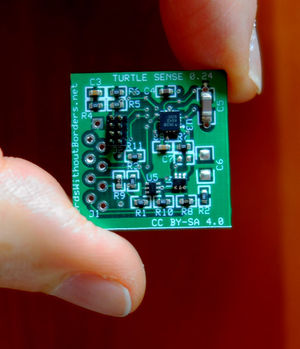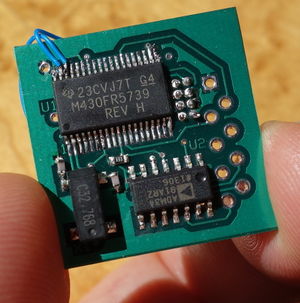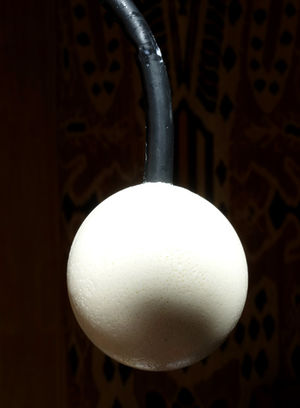Difference between revisions of "Turtle Sense Smart Sensor board v.0.24"
m (Sam moved page Circuit Description for Smart Sensor v.0.24 to Turtle Sense Smart Sensor board v.0.24) |
(dab) |
||
| (One intermediate revision by the same user not shown) | |||
| Line 2: | Line 2: | ||
[[File:PhaseTwoSmartSensorBottom.jpg|Thumb|right|300px|The microprocessor chip is near the top.]] | [[File:PhaseTwoSmartSensorBottom.jpg|Thumb|right|300px|The microprocessor chip is near the top.]] | ||
[[File:PhaseTwoSmartSensorCast.jpg|Thumb|right|300px|A Smart Sensor cast in a 1.5" ball of polyurethane.]] | [[File:PhaseTwoSmartSensorCast.jpg|Thumb|right|300px|A Smart Sensor cast in a 1.5" ball of polyurethane.]] | ||
| − | Smart Sensor v.0.24 is the sensor board which connects to the main [[ | + | Smart Sensor v.0.24 is the sensor board which connects to the main [[Turtle Sense communications board v.0.25a|Communications Board]]. The Smart Sensor contains a microprocessor, an accelerometer sensor IC, and a Transceiver IC. |
| + | * [[Turtle Sense Smart Sensor PCB Schematic v.0.24|PCB schematic]] | ||
==Microprocessor== | ==Microprocessor== | ||
Latest revision as of 17:38, 11 August 2014
Smart Sensor v.0.24 is the sensor board which connects to the main Communications Board. The Smart Sensor contains a microprocessor, an accelerometer sensor IC, and a Transceiver IC.
Microprocessor
The microprocessor (U1) is identical to the one on the Comm Board. It controls all the operation of the device. Programmed in C, it manages all the circuitry by:
- timing events
- controlling, reading and recording data from the accelerometer IC
- uploading data to the Comm Board
We selected theTexas Instruments MSP430FR5739 because it is extremely low power and contains 16 K of FRAM memory. Newer versions of this chip contain more memory and will likely be used in future versions. The 3.3V power from the Comm Board comes into U1 on AVCC and DVCC. The power ground connections are on AVSS and DVSS. There are three 8 bit I/O ports in the chip, labelled P1.0-P1.7, P2.0-P2.7, and P3.0-P3.7. Some of these ports are connected to the accelerometer (U3) and to the transceiver (U2), and many others are not used. There are two pins connected to an external crystal (X1). X1, along with C1 an C2, provide the chip with a precise 32.768 KHz clock which is used for the timing functions in the program. The chip also has other internal higher frequency clocks. Another set of pins on the chip, labelled J.0-J.3, -RST, and Test, are used for programming the chip. These pins are connected to a PC via the JTAG connector J2. Since the Smart Sensor is cast in polyurethane resin, after it is cast it cannot be programmed again. However, many of the operating parameters can later be changed by downloading them from the Comm Board.
Accelerometer
The accelerometer sensor IC (U3) is an Analog Devices ADXL362. The accelerometer measures the forces (including gravity) acting on it in 3 axes, and also temperature. The IC is extremely low powered and low noise. The microprocessor controls an analog switch (U4) which switches the 3.3V power going to the accelerometer. The accelerometer has two power inputs, labeled Vio and Vs. Vio is the power for the digital circuitry, and Vs powers the low level analog circuitry. Vs is filtered from any digital noise on Vio by R7 and C7. The output of U4 is normally connected to the 3.3V switch input. A logic high pulse from the microprocessor connects the 3.3V accelerometer power to ground to reset it. The accelerometer communicates with the microprocessor via a standard 4-wire SPI interface. These four signals are labeled /CS, CLK, MOSI, and MISO. In addition the accelerometer has two interrupt lines (INT1 and INT2) going to the microprocessor.
Transceiver
The Smart Sensor has an ADM 3483 RS485 transceiver IC (U2) identical to the one on the Comm Board. The two transceivers send and receive data over the sensor cable as differential twisted pairs. That is, there are two wires for transmitting data (labeled Y and Z on the transceiver), and two wires for receiving data (labeled A and B on the transceiver). The reason for this is to improve noise immunity on the cable and to allow faster data rates. Note that the data pairs are crossed between the two transceivers - that is, the send pair on one transceiver is connected to the receive pair on the other transceiver. The communication uses standard RS485 UART protocol at 115,200 baud. A resistor (R8) is a termination resistor on the receive inputs of U2 in order to prevent signal reflections travelling back to the Comm Board transceiver outputs. The RS485 Transceivers in the circuitry are capable of driving a signal through several hundred feet of cable. However, the response timing in the program may need to be adjusted if long lengths of cable are used.
| Comm Board | Signal | Molex 9-pin | Wire Color | Smart Sensor |
| J1 Pin No. | Pin No. | J1 Pin No. | ||
| 7 | Comm TX+ | 8 | Brn | 9 |
| 6 | Comm TX- | 7 | Brn-Wh | 8 |
| 9 | Comm RX+ | 9 | Or | 7 |
| 8 | Comm RX- | 6 | Or-Wh | 6 |
| 5 | TX/RX ON | 5 | Grn | 5 |
| 4 | SensorPwr | 4 | Grn-Wh | 4 |
| 3 | Interrupt | 3 | Blu | 3 |
| 2 | Tamper | 2 | Blu-Wh | 2 |
| 1 | Ground | 1 | Shield | 1 |


